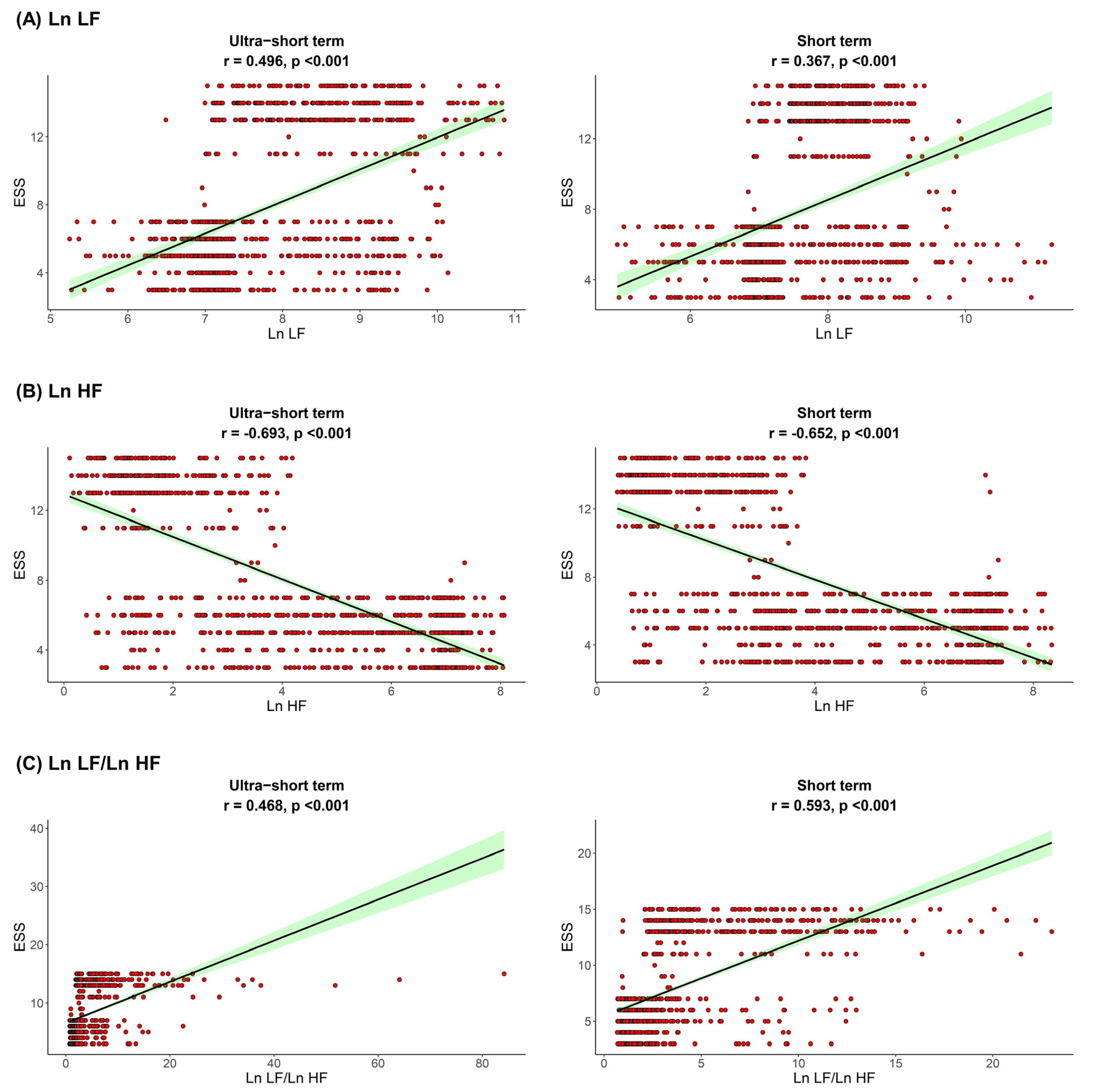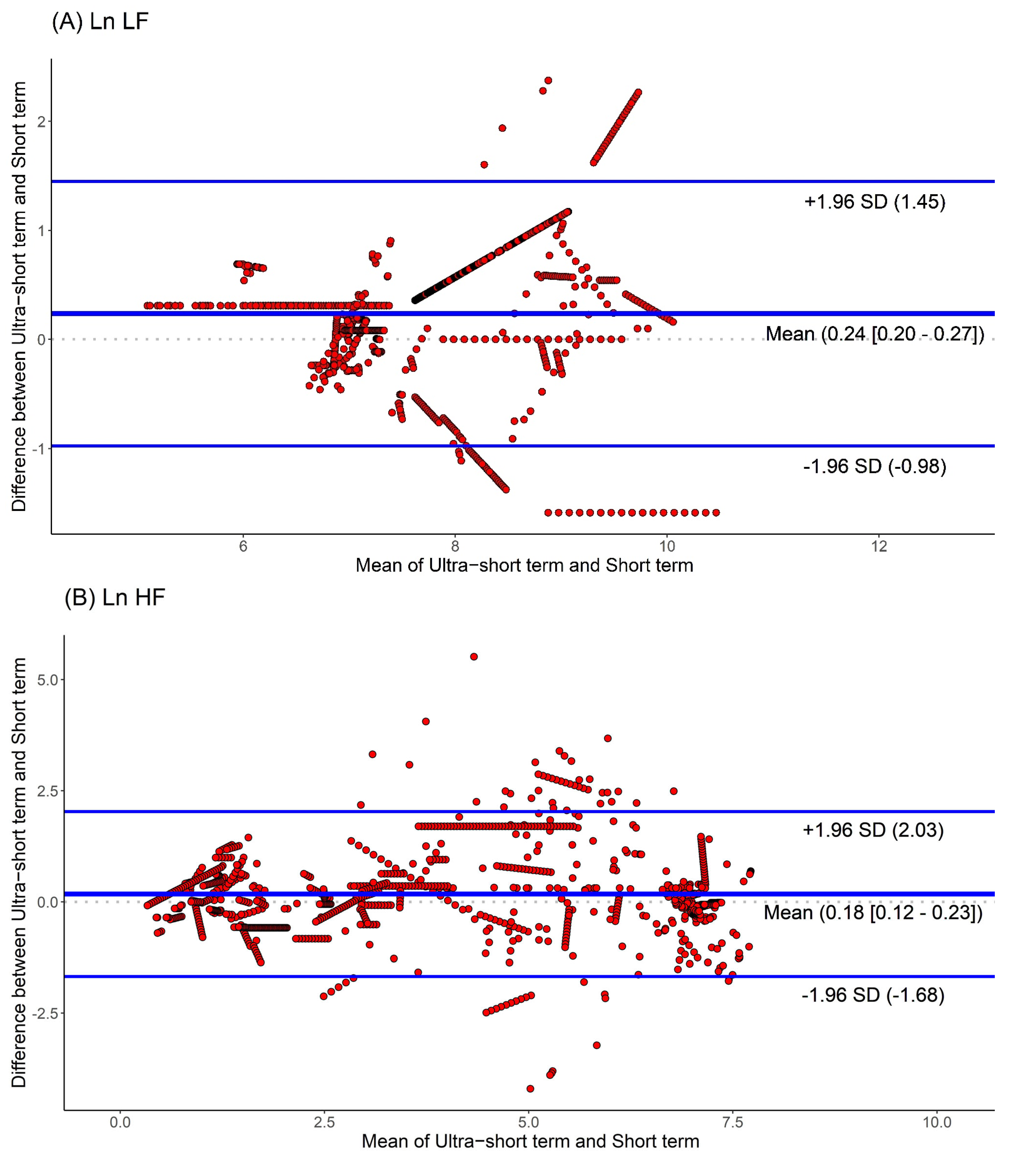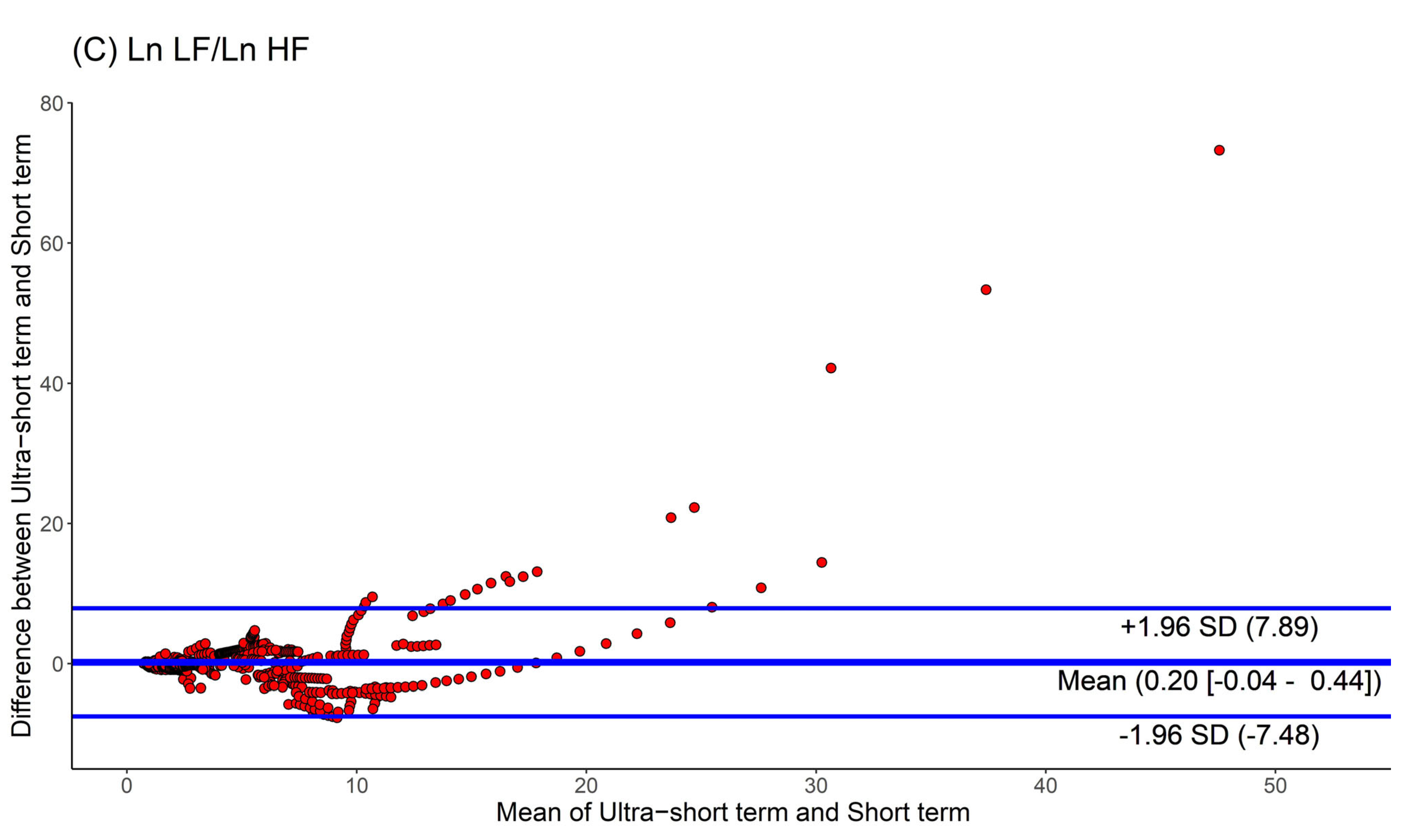Diagnostic Efficacy of Ultra-Short Term HRV Analysis in Obstructive Sleep Apnea
Abstract
1. Introduction
2. Materials and Methods
3. Results
4. Discussion
5. Conclusions
Author Contributions
Funding
Institutional Review Board Statement
Informed Consent Statement
Data Availability Statement
Acknowledgments
Conflicts of Interest
References
- Somers, V.K.; Dyken, M.E.; Clary, M.P.; Abboud, F.M. Sympathetic neural mechanisms in obstructive sleep apnea. J. Clin. Investig. 1995, 96, 1897–1904. [Google Scholar] [CrossRef] [PubMed]
- Partinen, M.; Jamieson, A.; Guilleminault, C. Long-term outcome for obstructive sleep apnea syndrome patients. Mortal. Chest 1988, 94, 1200–1204. [Google Scholar] [CrossRef] [PubMed]
- Smith, M.L.; Muenter, N.K. Effects of hypoxia on sympathetic neural control in humans. Respir. Physiol. 2000, 121, 163–171. [Google Scholar] [CrossRef]
- Garvey, J.F.; Taylor, C.T.; McNicholas, W.T. Cardiovascular disease in obstructive sleep apnoea syndrome: The role of intermittent hypoxia and inflammation. Eur. Respir. J. 2009, 33, 1195–1205. [Google Scholar] [CrossRef] [PubMed]
- Bradley, T.D.; Floras, J.S. Obstructive sleep apnoea and its cardiovascular consequences. Lancet 2009, 373, 82–93. [Google Scholar] [CrossRef]
- Kasai, T.; Floras, J.S.; Bradley, T.D. Sleep apnea and cardiovascular disease: A bidirectional relationship. Circulation 2012, 126, 1495–1510. [Google Scholar] [CrossRef]
- Heart rate variability: Standards of measurement, physiological interpretation and clinical use. Task Force of the European Society of Cardiology and the North American Society of pacing and electrophysiology. Circulation 1996, 93, 1043–1065. [CrossRef]
- Kim, Y.S.; Kim, S.Y.; Park, D.Y.; Wu, H.W.; Hwang, G.S.; Kim, H.J. Clinical implication of heart rate variability in obstructive sleep apnea syndrome patients. J. Craniofac. Surg. 2015, 26, 1592–1595. [Google Scholar] [CrossRef]
- Gula, L.J.; Krahn, A.D.; Skanes, A.; Ferguson, K.A.; George, C.; Yee, R.; Klein, G.J. Heart rate variability in obstructive sleep apnea: A prospective study and frequency domain analysis. Ann. Noninvasive Electrocardiol. 2003, 8, 144–149. [Google Scholar] [CrossRef]
- Aydin, M.; Altin, R.; Ozeren, A.; Kart, L.; Bilge, M.; Unalacak, M. Cardiac autonomic activity in obstructive sleep apnea: Time-dependent and spectral analysis of heart rate variability using 24-h Holter electrocardiograms. Tex. Heart Inst. J. 2004, 31, 132–136. [Google Scholar]
- Qin, H.; Keenan, B.T.; Mazzotti, D.R.; Vaquerizo-Villar, F.; Kraemer, J.F.; Wessel, N.; Tufik, S.; Bittencourt, L.; Cistulli, P.A.; de Chazal, P.; et al. Heart rate variability during wakefulness as a marker of obstructive sleep apnea severity. Sleep 2021, 44. [Google Scholar] [CrossRef] [PubMed]
- Noda, A.; Hayano, J.; Ito, N.; Miyata, S.; Yasuma, F.; Yasuda, Y. Very low frequency component of heart rate variability as a marker for therapeutic efficacy in patients with obstructive sleep apnea: Preliminary study [Preliminary study]. J. Res. Med. Sci. 2019, 24, 84. [Google Scholar] [CrossRef]
- Ravelo-García, A.G.; Saavedra-Santana, P.; Juliá-Serdá, G.; Navarro-Mesa, J.L.; Navarro-Esteva, J.; Álvarez-López, X.; Gapelyuk, A.; Penzel, T.; Wessel, N. Symbolic dynamics marker of heart rate variability combined with clinical variables enhance obstructive sleep apnea screening. Chaos 2014, 24, 024404. [Google Scholar] [CrossRef] [PubMed]
- Hilton, M.F.; Bates, R.A.; Godfrey, K.R.; Chappell, M.J.; Cayton, R.M. Evaluation of frequency and time-frequency spectral analysis of heart rate variability as a diagnostic marker of the sleep apnoea syndrome. Med. Biol. Eng. Comput. 1999, 37, 760–769. [Google Scholar] [CrossRef] [PubMed]
- Hayano, J.; Yuda, E. Pitfalls of assessment of autonomic function by heart rate variability. J. Physiol. Anthropol. 2019, 38, 3. [Google Scholar] [CrossRef]
- Castaldo, R.; Montesinos, L.; Melillo, P.; James, C.; Pecchia, L. Ultra-short term HRV features as surrogates of short term HRV: A case study on mental stress detection in real life. BMC Med. Inform. Decis. Mak. 2019, 19, 12. [Google Scholar] [CrossRef]
- Lee, S.; Hwang, H.B.; Park, S.; Kim, S.; Ha, J.H.; Jang, Y.; Hwang, S.; Park, H.K.; Lee, J.; Kim, I.Y. Mental stress assessment using ultra short term HRV analysis based on non-linear method. Biosensors 2022, 12, 465. [Google Scholar] [CrossRef]
- Castaldo, R.; Xu, W.; Melillo, P.; Pecchia, L.; Santamaria, L.; James, C. Detection of mental stress due to oral academic examination via ultra-short-term HRV analysis. Annu. Int. Conf. IEEE Eng. Med. Biol. Soc. 2016, 2016, 3805–3808. [Google Scholar] [CrossRef]
- Berry, R.B.; Budhiraja, R.; Gottlieb, D.J.; Gozal, D.; Iber, C.; Kapur, V.K.; Marcus, C.L.; Mehra, R.; Parthasarathy, S.; Quan, S.F.; et al. Rules for scoring respiratory events in sleep: Update of the 2007 AASM Manual for the Scoring of Sleep and Associated Events. Deliberations of the sleep Apnea Definitions Task Force of the American Academy of Sleep Medicine. J. Clin. Sleep Med. 2012, 8, 597–619. [Google Scholar] [CrossRef]
- Rajendra Acharya, U.; Paul Joseph, K.; Kannathal, N.; Lim, C.M.; Suri, J.S. Heart rate variability: A review. Med. Biol. Eng. Comput. 2006, 44, 1031–1051. [Google Scholar] [CrossRef]
- Altuncu, M.E.; Baspinar, O.; Keskin, M. The use of short-term analysis of heart rate variability to assess autonomic function in obese children and its relationship with metabolic syndrome. Cardiol. J. 2012, 19, 501–506. [Google Scholar] [CrossRef] [PubMed][Green Version]
- Lutfi, M.F. Autonomic modulations in patients with bronchial asthma based on short-term heart rate variability. Lung India 2012, 29, 254–258. [Google Scholar] [CrossRef] [PubMed]
- Na, K.S.; Lee, N.Y.; Park, S.H.; Park, C.K. Autonomic dysfunction in normal tension glaucoma: The short-term heart rate variability analysis. J. Glaucoma 2010, 19, 377–381. [Google Scholar] [CrossRef] [PubMed]
- He, B.; Li, W.; Zhang, X.; Wu, Y.; Liu, J.; Brewer, L.M.; Yu, L. The analysis of how apnea influences the autonomic nervous system using short-term heart rate variability indices. J. Healthc. Eng. 2020, 2020, 6503715. [Google Scholar] [CrossRef] [PubMed]
- Fei, L.; Copie, X.; Malik, M.; Camm, A.J. Short- and long-term assessment of heart rate variability for risk stratification after acute myocardial infarction. Am. J. Cardiol. 1996, 77, 681–684. [Google Scholar] [CrossRef]
- Fei, L.; Statters, D.J.; Anderson, M.H.; Malik, M.; Camm, A.J. Relationship between short- and long-term measurements of heart rate variability in patients at risk of sudden cardiac death. Pacing Clin. Electrophysiol. 1994, 17, 2194–2200. [Google Scholar] [CrossRef]
- Melillo, P.; De Luca, N.; Bracale, M.; Pecchia, L. Classification tree for risk assessment in patients suffering from congestive heart failure via long-term heart rate variability. IEEE J. Biomed. Health Inform. 2013, 17, 727–733. [Google Scholar] [CrossRef]
- Shahbazi, F.; Asl, B.M. Generalized discriminant analysis for congestive heart failure risk assessment based on long-term heart rate variability. Comput. Methods Programs Biomed. 2015, 122, 191–198. [Google Scholar] [CrossRef]
- Kumari, P.; Mathew, L.; Syal, P. Increasing trend of wearables and multimodal interface for human activity monitoring: A review. Biosens. Bioelectron. 2017, 90, 298–307. [Google Scholar] [CrossRef]
- Finžgar, M.; Podržaj, P. Feasibility of assessing ultra-short-term pulse rate variability from video recordings. PeerJ 2020, 8, e8342. [Google Scholar] [CrossRef]
- Moya-Ramon, M.; Mateo-March, M.; Peña-González, I.; Zabala, M.; Javaloyes, A. Validity and reliability of different smartphones applications to measure HRV during short and ultra-short measurements in elite athletes. Comput. Methods Programs Biomed. 2022, 217, 106696. [Google Scholar] [CrossRef] [PubMed]
- Hietakoste, S.; Korkalainen, H.; Kainulainen, S.; Sillanmäki, S.; Nikkonen, S.; Myllymaa, S.; Duce, B.; Töyräs, J.; Leppänen, T. Longer apneas and hypopneas are associated with greater ultra-short-term HRV in obstructive sleep apnea. Sci. Rep. Sci. Rep. 2020, 10, 21556. [Google Scholar] [CrossRef] [PubMed]
- Wu, L.; Shi, P.; Yu, H.; Liu, Y. An optimization study of the ultra-short period for HRV analysis at rest and post-exercise. J. Electrocardiol. 2020, 63, 57–63. [Google Scholar] [CrossRef] [PubMed]
- Aytemir, K.; Deniz, A.; Yavuz, B.; Ugur Demir, A.; Sahiner, L.; Ciftci, O.; Tokgozoglu, L.; Can, I.; Sahin, A.; Oto, A. Increased myocardial vulnerability and autonomic nervous system imbalance in obstructive sleep apnea syndrome. Respir. Med. 2007, 101, 1277–1282. [Google Scholar] [CrossRef] [PubMed][Green Version]
- Xie, J.; Yu, W.; Wan, Z.; Han, F.; Wang, Q.; Chen, R. Correlation analysis between obstructive sleep apnea syndrome (OSAS) and heart rate variability. Iran J. Public Health. 2017, 46, 1502–1511. [Google Scholar]
- Busek, P.; Vanková, J.; Opavský, J.; Salinger, J.; Nevsímalová, S. Spectral analysis of the heart rate variability in sleep. Physiol. Res. 2005, 54, 369–376. [Google Scholar] [CrossRef]
- Chouchou, F.; Pichot, V.; Barthélémy, J.C.; Bastuji, H.; Roche, F. Cardiac sympathetic modulation in response to apneas/hypopneas through heart rate variability analysis. PLoS ONE 2014, 9, e86434. [Google Scholar] [CrossRef]
- Kim, D.K.; Lee, B.C.; Park, K.J.; Son, G.M. Effect of Obstructive Sleep Apnea on Immunity in Cases of Chronic Rhinosinusitis With Nasal Polyps. Clin. Exp. Otorhinolaryngol. 2021, 14, 390–398. [Google Scholar] [CrossRef]
- Liu, X.; Ma, Y.; Ouyang, R.; Zeng, Z.; Zhan, Z.; Lu, H.; Cui, Y.; Dai, Z.; Luo, L.; He, C.; et al. The relationship between inflammation and neurocognitive dysfunction in obstructive sleep apnea syndrome. J. Neuroinflammation 2020, 17, 229. [Google Scholar] [CrossRef]





| Mild | Moderate | Severe | |
|---|---|---|---|
| Number | 238 (23.3%) | 331 (32.4%) | 452 (44.3%) |
| Age | 53.87 ± 7.55 | 56.14 ± 7.91 | 57.06 ± 8.53 |
| Sex | |||
| Male | 206 (86.6%) | 237 (71.6%) | 403 (89.2%) |
| Female | 32 (13.4%) | 94 (28.4%) | 49 (10.8%) |
| Body mass index (kg/m2) | 24.2 ± 3.8 | 26.4 ± 4.8 | 27.2 ± 3.1 |
| Hypertension | 168 | 216 | 285 |
| ESS | 5.06 ± 1.34 | 5.56 ± 2.24 | 11.11 ± 4.04 |
| Total sleep Time (min) | 363.93 ± 56.94 | 367.12 ± 56.43 | 375.67 ± 55.23 |
| Sleep latency (min) | 44.70 ± 9.64 | 45.94 ± 8.19 | 45.76 ± 7.72 |
| Sleep efficiency (%) | 79.74 ± 6.63 | 79.59 ± 6.42 | 79.30 ± 6.53 |
| AHI | 9.34 ± 2.37 | 20.50 ± 3.86 | 60.69 ± 17.38 |
| ODI | 7.87 ± 2.23 | 9.43 ± 3.96 | 33.62 ± 17.21 |
| Ultra-Short Term | Short Term | p Value | |
|---|---|---|---|
| Ln TP | 7.47 ± 0.34 | 7.29 ± 0.47 | <0.001 |
| Ln VLF | 6.97 ± 0.57 | 6.93 ± 0.61 | 0.504 |
| Ln LF | 7.24 ± 0.91 | 7.20 ± 1.21 | 0.733 |
| Ln HF | 7.10 ± 0.29 | 6.97 ± 0.61 | 0.002 |
| Ln LF/Ln HF | 1.02 ± 0.15 | 1.04 ± 0.20 | 0.221 |
| Ultra-Short Term | Short Term | p Value | |
|---|---|---|---|
| Ln TP | 7.43 ± 0.35 | 7.30 ± 0.46 | <0.001 |
| Ln VLF | 7.19 ± 0.58 | 7.13 ± 0.53 | 0.152 |
| Ln LF | 7.56 ± 1.08 | 7.41 ± 1.00 | 0.071 |
| Ln HF | 5.18 ± 1.24 | 4.71 ± 1.45 | <0.001 |
| Ln LF/Ln HF | 1.60 ± 0.64 | 1.78 ± 0.75 | 0.001 |
| Ultra-Short Term | Short Term | p Value | |
|---|---|---|---|
| Ln TP | 7.45 ± 0.34 | 7.22 ± 0.50 | <0.001 |
| Ln VLF | 7.19 ± 0.52 | 7.02 ± 0.58 | <0.001 |
| Ln LF | 8.36 ± 0.97 | 7.95 ± 0.57 | <0.001 |
| Ln HF | 1.80 ± 0.92 | 1.82 ± 1.06 | 0.849 |
| Ln LF/Ln HF | 6.93 ± 7.17 | 6.33 ± 4.14 | 0.125 |
Publisher’s Note: MDPI stays neutral with regard to jurisdictional claims in published maps and institutional affiliations. |
© 2022 by the authors. Licensee MDPI, Basel, Switzerland. This article is an open access article distributed under the terms and conditions of the Creative Commons Attribution (CC BY) license (https://creativecommons.org/licenses/by/4.0/).
Share and Cite
Ha, S.-S.; Kim, D.-K. Diagnostic Efficacy of Ultra-Short Term HRV Analysis in Obstructive Sleep Apnea. J. Pers. Med. 2022, 12, 1494. https://doi.org/10.3390/jpm12091494
Ha S-S, Kim D-K. Diagnostic Efficacy of Ultra-Short Term HRV Analysis in Obstructive Sleep Apnea. Journal of Personalized Medicine. 2022; 12(9):1494. https://doi.org/10.3390/jpm12091494
Chicago/Turabian StyleHa, Seung-Su, and Dong-Kyu Kim. 2022. "Diagnostic Efficacy of Ultra-Short Term HRV Analysis in Obstructive Sleep Apnea" Journal of Personalized Medicine 12, no. 9: 1494. https://doi.org/10.3390/jpm12091494
APA StyleHa, S.-S., & Kim, D.-K. (2022). Diagnostic Efficacy of Ultra-Short Term HRV Analysis in Obstructive Sleep Apnea. Journal of Personalized Medicine, 12(9), 1494. https://doi.org/10.3390/jpm12091494






